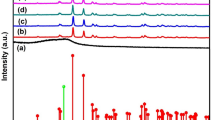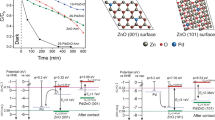Abstract
In the present work, a new Pd-doped ZnWO4 nanocomposite materials have been synthesized via hydrothermal technique. Several characterization techniques for measure phase and composition of the prepared nanoparticles were used, and their structures were characterized and confirmed. In addition, the effect of Pd percent on physical and chemical properties of ZnWO4 has been studied in the form of Pd/ZnWO4 nanocomposites. XRD data confirm that the formed phase for pure ZnWO4 and Pd-doped ZnWO4 samples was in the form of Zinc tungsten oxide. A slight shift in the XRD diffraction peaks to high angle was also observed while adding palladium to ZnWO4. All samples showed comparable morphologies in the TEM images. About 62 nm pore size distribution was mentioned for 1.65 wt% Pd/ZnWO4 nanocomposite. The desired Pd/ZnWO4 nanocomposites have been also examined for the removal of atrazine using visible light assistance. 1.65 wt% Pd/ZnWO4 nanocomposite shows the highest photocatalytic activity as an efficient photocatalyst for atrazine degradation, due to its low bandgap, low e–h recombination rate, and high BET surface area. Furthermore, the advantages and limitations of the process in the selected application were evaluated. Concentration of atrazine, dosages of photocatalyst, and treatment performance which affect atrazine were discussed and evaluated as main operating conditions. The photocatalytic stability of 1.65 wt% Pd/ZnWO4 photocatalyst for atrazine degradation was intended for five times without affecting its efficiency.











Similar content being viewed by others
References
Alinsafi A, Evenou F, Abdulkarim EM, Pons MN, Zahraa O, Benhammou A, Yaacoubi A, Nejmeddine A (2007) Treatment of textile industry wastewater by supported photocatalysis. Dyes Pigm 74:439–445
Atar N, Olgun A, Çolak F (2008) Thermodynamic, equilibrium and kinetic study of the biosorption of basic blue 41 using bacillus maceran. Eng Life Sci 8:499–506
Banks KE, Hunter DH, Wachal DJ (2005) Chlorpyrifos in surface waters before and after a federally mandated ban. Environ Int 31:351–356
Bessekhouad Y, Chaoui N, Trzpit M, Ghazzal N, Robert D, Weber JV (2006) UV–vis versus visible degradation of Acid Orange II in a coupled CdS/TiO2 semiconductors suspension. J Photochem Photobiol A 183:218–224
Beydoun D, Amal R, Low G, McEvoy S (1999) Role of nanoparticles in photocatalysis. J Nanopart Res 1:439–458
Chen XP, Xiao F, Ye S, Huang XY, Dong GP, Zhang QY (2011) ZnWO4:Eu3+ nanorods: a potential tunable white light-emitting phosphors. J Alloy Compd 509:1355–1359
Dong X, Zhu L, Wang J, Wang J, Xie H, Hou X, Jia W (2009) Effects of atrazine on cytochrome P450 enzymes of zebrafish (Danio rerio). Chemosphere 77:404–412
Dostanić J, Grbić B, Radić N, Stefanov P, Šaponjić Z, Buha J, Mijin D (2012) Photodegradation of an azo pyridone dye using TiO2 films prepared by the spray pyrolysis method. Chem Eng J 180:57–65
Eriksson E, Baun A, Mikkelsen PS, Ledin A (2007) Risk assessment of xenobiotics in stormwater discharged to Harrestrup Å, Denmark. Desalination 215:187–197
Esfandyarpour R, Esfandyarpour H, Javanmard M, Harris JS, Davis RW (2013a) Label-free electronic probing of nucleic acids and proteins at the nanoscale using the nanoneedle biosensor. Biomicrofluidics 7:044114
Esfandyarpour R, Esfandyarpour H, Harris JS, Davis RW (2013b) Simulation and fabrication of a new novel 3D injectable biosensor for high throughput genomics and proteomics in a lab-on-a-chip device. Nanotechnology 24:465301
Esfandyarpour R, Esfandyarpour H, Javanmard M, Harris JS, Davis RW (2013c) Microneedle biosensor: a method for direct label-free real time protein detection. Sens Actuators B 177:848–855
Gupta VK, Mohan D, Sharma S, Sharma M (2000) Removal of basic dyes (Rhodamine B and Methylene Blue) from aqueous solutions using bagasse fly ash. Sep Sci Technol 35:2097–2113
Hamrouni A, Moussa N, Di Paola A, Palmisano L, Houas A, Parrino F (2015) Photocatalytic activity of binary and ternary SnO2–ZnO–ZnWO4 nanocomposites. J Photochem Photobiol A 309:47–54
Huang G, Shi R, Zhu Y (2011) Photocatalytic activity and photoelectric performance enhancement for ZnWO4 by fluorine substitution. J Mol Catal A 348:100–105
Jacobsen CS, Hjelmsø MH (2014) Agricultural soils, pesticides and microbial diversity. Curr Opin Biotechnol 27:15–20
Kaushik A, Sharma HR, Jain S, Dawra J, Kaushik CP (2010) Pesticide pollution of River Ghaggar in Haryana, India. Environ Monit Assess 160:61–69
Kawahara T, Ozawa T, Iwasaki M, Tada H, Ito S (2003) Photocatalytic activity of rutile–anatase coupled TiO2 particles prepared by a dissolution–reprecipitation method. J Colloid Interface Sci 267:377–381
Ke J, Niu C, Zhang J, G Zeng (2014) Significantly enhanced visible light photocatalytic activity and surface plasmon resonance mechanism of Ag/AgCl/ZnWO4 composite. J Mol Catal A 395:276–282
Lim CS, Ryu JH, Choi JG, Park CY, Oh WC (2011) Preparation and characterization of Ag incorporated ZnWO4/zeolite composites by cyclic microwave metathetic method. J Ceram Proc Res 12:218–221
Lin J, Lin J, Zhu Y (2007) Controlled synthesis of the ZnWO4 nanostructure and effects on the photocatalytic performance. Inorg Chem 46:8372–8378
Lu JC, Liu MC, Zhou SQ, Zhou X, Yang YG (2017) Electrospinning fabrication of ZnWO4 nanofibers and photocatalytic performance for organic dyes. Dyes Pigm 136:1–7
Malato S, Blanco J, Cáceres J, Fernández-Alba AR, Agüera A, Rodríguez A (2002) Photocatalytic treatment of water-soluble pesticides by photo-Fenton and TiO2 using solar energy. Catal Today 76:209–220
Miller SM, Sweet CW, DePinto JV, Hornbuckle KC (1999) Atrazine and nutrients in precipitation: results from the Lake Michigan Mass Balance Study. Environ Sci Technol 34:55–61
Mohan N, Balasubramanian N, Subramanian V (2001) Electrochemical treatment of simulated textile effluent. Chem Eng Technol 24:749–753
Neumann M, Schulz R, Schäfer K, Müller W, Mannheller W, Liess M (2002) The significance of entry routes as point and non-point sources of pesticides in small streams.Water Res 36:835–842
Pan L, Zou J-J, Wang S, Huang Z-F, Zhang X, Wang L (2013) Enhancement of visible-light-induced photodegradation over hierarchical porous TiO2 by nonmetal doping and water-mediated dye sensitization. Appl Surf Sci 268:252–258
Pekakis PA, Xekoukoulotakis NP, Mantzavinos D (2006) Treatment of textile dyehouse wastewater by TiO2 photocatalysis. Water Res 40:1276–1286
Rao L, Xu J, Ao Y, Wang P (2014) In-situ growth of zinc tungstate nanorods on graphene for enhanced photocatalytic performance. Mater Res Bull 57:41–46
Roy SC, Varghese OK, Paulose M, Grimes CA (2010) Toward solar fuels: photocatalytic conversion of carbon dioxide to hydrocarbons. ACS Nano 4:1259–1278
Sakkas VA, Albanis TA (2003) Photocatalyzed degradation of the biocides chlorothalonil and dichlofluanid over aqueous TiO2 suspensions. Appl Catal B 46:175–188
Shi R, Wang Y, Li D, Xu J, Zhu Y (2010) Synthesis of ZnWO4 nanorods with [100] orientation and enhanced photocatalytic properties. Appl Catal B 100:173–178
Sojka-Ledakowicz J, Zylla R, Mrozinska Z, Pazdzior K, Klepacz-Smolka A, Ledakowicz S (2010) Application of membrane processes in closing of water cycle in a textile dye-house. Desalination 250:634–638
Song XC, Li WT, Huang WZ, Zhou H, Zheng YF, Yin HY (2015) A novel p–n heterojunction BiOBr/ZnWO4: Preparation and its improved visible light photocatalytic activity. Mater Chem Phys 160:251–256
Velmurugan R, Swaminathan M (2011) An efficient nanostructured ZnO for dye sensitized degradation of Reactive Red 120 dye under solar light. Sol Energy Mater Sol Cells 95:942–950
Wang YJ, Li LP, Li GS (2017) Solvothermal synthesis, characterization and photocatalytic performance of Zn-rich ZnWO4 nanocrystals. Appl Surf Sci 393:159–167
Whyatt RM, Garfinkel R, Hoepner LA, Holmes D, Borjas M, Williams MK, Reyes A, Rauh V, Perera FP, Camann DE (2007) Within-and between-home variability in indoor-air insecticide levels during pregnancy among an inner-city cohort from New York City. Environ Health Perspect 115:383–389
Yu CL, Yu JC (2009) Sonochemical fabrication, characterization and photocatalytic properties of Ag/ZnWO4 nanorod catalyst. Mater Sci Eng B 164:16–22
Zhang KL, Liu CM, Huang FQ, Zheng C, Wang WD (2006) Study of the electronic structure and photocatalytic activity of the BiOCl photocatalyst. Appl Catal B 68:125–129
Zhao W, Song X, Chen G, Sun S (2009) One-step template-free synthesis of ZnWO4 hollow clusters. J Mater Sci 44:3082–3087
Acknowledgements
This Project was funded by the Deanship of Scientific Research (DSR) at King Abdulaziz University, Jeddah, under Grant No. (G-81-247-38). The authors therefore acknowledge, with thanks, DSR for technical and financial support.
Author information
Authors and Affiliations
Corresponding author
Additional information
Publisher’s Note
Springer Nature remains neutral with regard to jurisdictional claims in published maps and institutional affiliations.
Rights and permissions
About this article
Cite this article
Al-Amshany, Z.M., Hussein, M.A. Novel Pd/ZnWO4 nanocomposite materials for photocatalytic degradation of atrazine. Appl Nanosci 8, 527–536 (2018). https://doi.org/10.1007/s13204-018-0694-z
Received:
Accepted:
Published:
Issue Date:
DOI: https://doi.org/10.1007/s13204-018-0694-z




